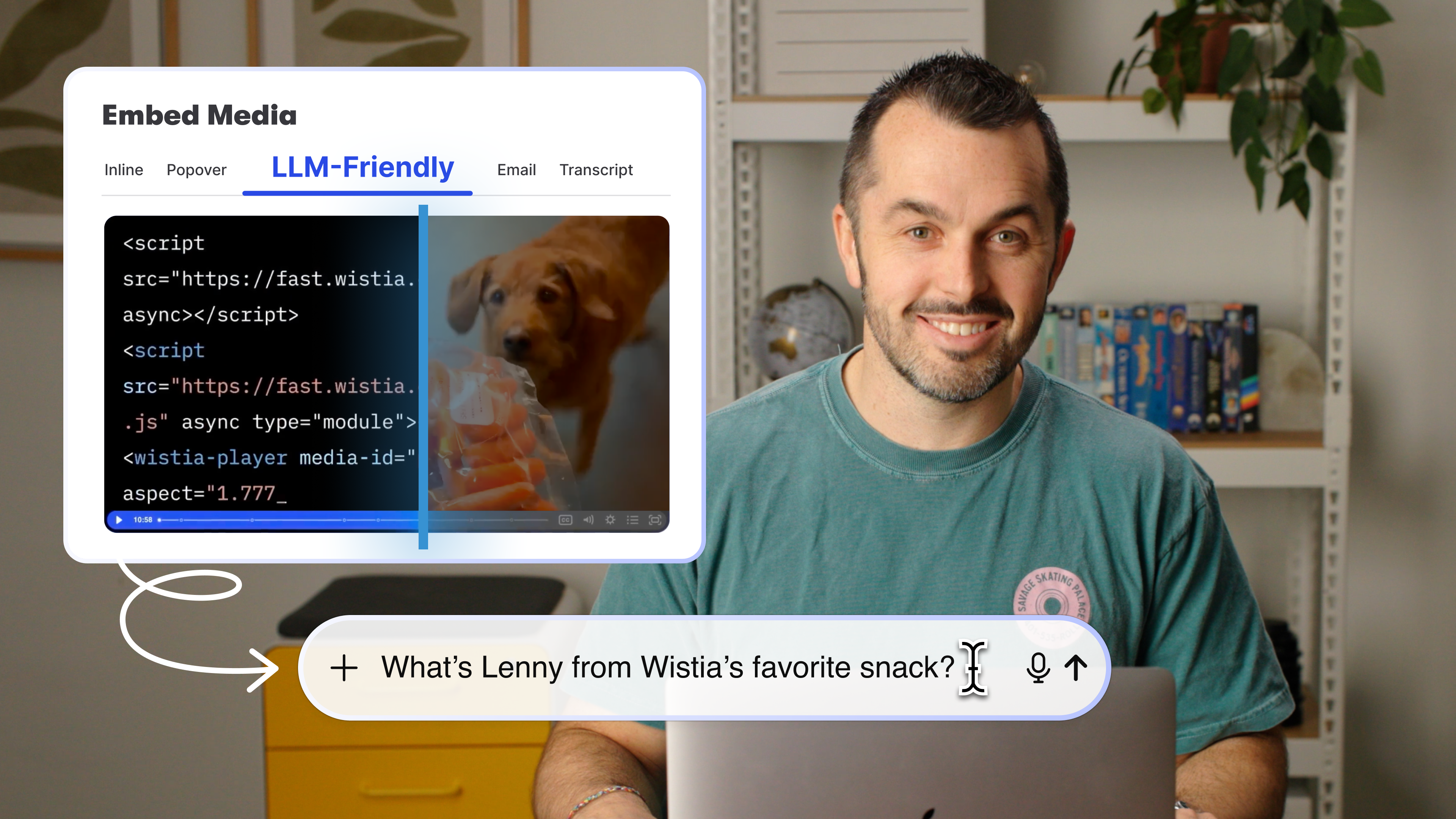5 Types of Video Series Your Business Can Make Today
October 23, 2019
Topic tags
Here at Wistia, we’ve been making videos that entertain, educate, and delight for years, but we’ve recently started investing more in creating our very own episodic video content. Last year we made a Webby-award winning docu-series called One, Ten, One Hundred, this year we’re producing a talk show for marketers called Brandwagon, and we’ve got lots more in the works that we can’t wait to share with you in the coming months.
We’re going all-in on building a brand people love with Brand Affinity Marketing, and as you may have seen by checking out our four-step playbook (if you haven’t read it yet, we highly recommend you do!), investing in creating binge-worthy content is a key component of this strategy. What does “binge-worthy content” mean, exactly? Well, binge-worthy content is simply entertaining content that’s so good consumers can’t help but want to watch, listen, or read a lot of it in one sitting.
And while this type of content can be a podcast, a series of blog posts, or even several hard-cover books, we think that a long-form video series (or several!) is the best way to build more affinity for your brand and drive quality leads. Now, all you need to get started with your first video series is a little inspiration. So, let’s dive into all the different types of series you can start creating today!
Here's what we’ll cover (click to jump down)
Documentary or docu-series
Whether you go with a scripted or run-and-gun-style documentary, this is an excellent format to consider for your brand’s next video series. This type of series typically follows a cast of people and has little-to-no traditional structure. Depending on the format you choose, however, you have the option of pointing the content in one direction or another with the goal of ending up at a specific destination, whether literal or metaphorical.
Wistia’s own docu-series, One, Ten, One Hundred, is actually a great example of what a hybrid-style documentary can look like for a business. Ultimately, we knew where we wanted to go with the series — we wanted to see how three different ads produced with three different budgets would perform against one another — but we weren’t exactly sure what the results would be. We then captured all the action in real-time throughout the entire creative process and released it in a series of episodes.
Chances are you’ve already seen shows that fit into the documentary or docu-series category, like Last Chance U, Wild Wild Country, or Fyre) to name a few. But, what businesses (besides Wistia) are making this type of show? Well, one brand that jumps out to us is Mailchimp Presents and their documentary series, Second Act. This show follows five people who’ve chosen a new direction in their careers and are defining their own version of success along the way. From a postal-worker-turned-violin-maker to a lawyer who’s looking to lead a more calm and meditative life, there’s no shortage of interesting stories to be shared here.
Things to consider when making a documentary:
With engaging stories and the right folks on camera to tell those stories, you can create something really compelling that’ll resonate with your target audience. Plus, because of the nature of this type of show, the topic you choose to explore can do a lot of the heavy lifting for you from a storytelling perspective, which means less time scripting.
Talk show or interview
A talk show or interview-style show is something most of us are already familiar with in our personal lives — just think about all the late-night shows you’ve grown up watching. These shows typically feature one host that leads the interview week after week, with a series of different special guests on each episode.
“These shows typically feature one host that leads the interview week after week, with a series of different special guests on each episode.”
This type of video series is perfect for businesses that want to start experimenting with a slightly less-risky and more formulaic show that can be repeated and improved upon over time. If you’re looking for some inspiration for talk shows in the B2B space, be sure to check out Nextiny’s Coffee Talks, Drift’s Coffee with a CMO, and our very own Brandwagon, to name a few (we missed the coffee trend here). Here’s a recent Coffee Talks episode featuring our very own, Phil Nottingham:
When creating a talk show or interview-style series for your business, be sure to reference some of your favorite TV shows for new ideas. What segments make “The Tonight Show Starring Jimmy Fallon” so great? What is it about the structure of “Jimmy Kimmel Live” that makes viewers come back for more? Should you change your name to Jimmy? All jokes aside, there’s no better place to start when crafting your talk show than to look at what’s worked for other shows that already exist today.
Things to consider when making a talk show:
One of the biggest indicators of success when it comes to shooting a talk show for your business is who’s on camera week after week — in other words, you need to have a charismatic host. If you have an awesome host in mind, you also want to consider who you might be able to get in the door as guests. Does your host or someone at your business have a good network of potential guests you can reach out to? Typically, for your show to draw the kind of viewership you want from your niche audience, the guests you feature have to be well-known or reputable enough in your industry to entice viewers to tune in.
Product review or critique
A product review or critique-style show is another popular video series format that’s been around for quite some time now (did someone say QVC?). Whether you unbox a hot new piece of tech on camera or review the design of a website through a critical lens, the key takeaway remains the same — educating and informing your audience.
Typically this content is centered around a product or best practice. When making a product review or critique video, it’s important to consider what unique expertise your business brings to the table. At the end of the day, if you’re going to speak about your subject matter at length on camera, it’s wise to be an expert in the space.
Take, for example, Zaius' Marketing Unboxed series. As a B2C customer relationship management platform for marketers, Zaius is uniquely equipped to host a “ … video series that pulls back the curtain on how today’s top ecommerce brands are marketing to their customers.” Throughout the series, they aim to share learnings with marketers that can help them inform their own strategies and stay ahead of the curve. Here’s an example of a video from this series:
While Marketing Unboxed was a literal unboxing video, your business could also create a critique-style show that educates your audience about best practices in the space you’re most knowledgeable and passionate about. Unbounce did this a few years ago with their Landing Page Sessions series, but more recently, ProfitWell has been diving head-first into the critique-style show format with their Pricing Page Teardown series. Every week, ProfitWell, a subscription software company, shares a new video as part of this series that covers what’s working and what’s not on a company’s pricing page to uncover what opportunities they’re leaving on the table.
“Your business could also create a critique-style show that educates your audience about best practices in the space you’re most knowledgeable and passionate about.”
Things to consider when making a product review or critique show:
If your business sells software that’s catered to a specific industry or niche, a review show that covers a product (or category of products) your target audience may use regularly could be a great idea for a show. For example, we know that a large part of our audience here at Wistia is made up of budding videographers, so it might make sense for us to create an unboxing or product review show for audio and video gear.
Similarly, if you want to further position your business as thought leaders in a specific space (which chances are you do!), you could create a critique show that highlights just how much you or someone on your team knows about said industry. For example, if your business creates email software, you could do a critique show about marketing emails from different industries and share tips about what might make them better.
Satire or drama
Now, we’re starting to tread into slightly advanced waters here with this type of video series, so for folks who are just getting started, you may want to proceed with just a little bit of caution. That’s not to say creating a series in the satire or drama genre is impossible — it just means you’ll likely have to do more heavy-lifting from pre-production all the way through post-production. This is primarily because both of these types of shows are very character and narrative-driven, which requires more storyboarding and scripting than say, an unboxing series might.
Satirical shows typically blend humor with criticism for the purpose of exploring our humanity in one way or another. Satirical TV shows have been a staple of television for years — Veep, The Office, Park and Rec, The Simpsons, and many more — so naturally, this style of show might come to mind when you start concepting a new video series for your business. Mailchimp Presents hits the satirical nail on the head with their series, Taking Stock. Season one follows photographer Hannah as she “..navigates the day-to-day of a quirky stock photography agency while struggling to find the passion for her next move.” Watch the trailer to get a taste of what it’s all about:
Dramas are usually narratively complex and follow characters along a journey, while also exploring an array of topics from politics and corruption to societal ills and intolerance. From Black Mirror and Mindhunter to Breaking Bad and Ozark, there’s really something for everyone.
One business that has managed to pull off a dramatic video series particularly well is HP — yes, Hewlett-Packard, the IT company. Now in its third series, The Wolf highlights how corporate networks can be hacked and what companies need to do to protect themselves. Christian Slater stars alongside Jonathan Banks in this production, which should give you some idea of the production budget for The Wolf (we’re going to guess it’s somewhere in the ballpark of … large).
Things to consider when making a satire or drama series:
If you plan on shooting this type of series in-house (that is, not outsourcing to an agency or buying the rights to a pre-existing show), we recommend dabbling in this world once you already have a video series or two under your belt. In order to execute on this type of show in a way that feels authentic, you’ll likely need a substantial team with prior experience in the show creation space to help you get all your ducks in a row.
Travelogue
Ah, the travelogue. Who doesn’t love getting whisked away to somewhere new and exciting? This type of video series typically follows a format where a host travels to a new location on each episode to discover and explore a specific topic. It could be a different restaurant, culture, or even a different fishing hole — regardless of the “thing,” each episode has a core mission that the content of the video must fall into and align with overall. Now, we bet you’ve already seen your fair share of travelogue shows — do Diners, Drive-ins, and Dives, Parts Unknown, Expedition Unknown, and River Monster ring a bell?
“This type of video series typically follows a format where a host travels to a new location on each episode to discover and explore a specific topic.”
One of the nice things about this style of show is that your location and the set for your shoot is predetermined by the guests you book for your show. This gives you the chance to focus more on getting the most out of your guests and finding the best stories. ThriveHive, a marketing and lead management solution, does just that on their latest video series, Locals. In this original series, they capture the adventures that come with local business ownership. Check out this episode featuring Cambridge Naturals (a local favorite!):
Another popular brand that’s doing the travelogue genre justice is YETI with their Hungry Life series. On this episodic show, Eduard Garcia, a professional chef, hunter, and wild foods forager, makes a meal and learns from local pros on every episode, proving that food is an integral part of any adventure. YETI, an outdoor lifestyle product manufacturer, speaks directly to their niche audience here with Hungry Life (without pushing their own products). Looking for other awesome travelogue examples? Check out Death Wish Coffee’s latest series, Grind It Out, or ezCater’s Restaurant Roots.
Things to consider when making a travelogue series:
From software to coffee, regardless of the industry your business is in, the opportunities for a travelogue series are endless. With a built-in setting, seemingly infinite b-roll opportunities, and talent that are eager and willing to share their stories (assuming you do your homework when sourcing your guests!) your travelogue series is set up for success from day one. Plus, if you or someone at your business is already familiar with shooting customer testimonial videos, this could be a great place to start as the storytelling formats are pretty similar. Just remember, keep the focus on your subject and not on your product or service. The content needs to provide value in a way that connects with viewers on a deep, personal level in order to resonate, so it shouldn’t feel like a clever ad for your business.
Get started on your first video series today
There are so many different types of video series your business can start experimenting with and we hope that after reading this post, you feel super excited and inspired to get started. Whatever type of series you end up creating, remember that the key ingredient to a successful video series is a great idea — your content won’t succeed without it.
At the end of the day, it doesn’t matter how much money you spend on the production of your series if the content isn’t grounded in a solid idea from the start. So, always be sure to spend a healthy amount of time in the ideation stage before you start shooting!






